 |
| Jewish Wedding in Morocco by Eugène Delacroix (1839) |
Eugène Delacroix’s Jewish Wedding in Morocco Analysis
 |
| Women of Algiers in Their Apartment by Eugène Delacroix (1834) |
 |
| The Entry of the Crusaders in Constantinople by Eugène Delacroix (1840) |
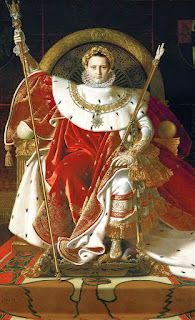 |
| Napoleon I on His Imperial Throne by Jean-Auguste-Dominique Ingres (1806) |
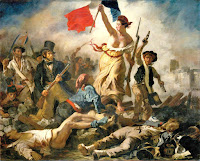 |
| Liberty Leading the People by Eugène Delacroix (1830) |
Delacroix Painting Technique in Jewish Wedding in Morocco
 |
| The Fanatics of Tangier by Eugène Delacroix (1837-1838) |
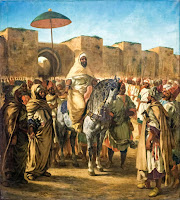 |
| The Sultan of Morocco by Eugène Delacroix (1845) |
 |
| Jewish Wedding in Morocco Detail of Dancing Woman |
Jewish Wedding in Morocco Delacroix Story of Jews in Africa
 |
| Portrait of Count Charles-Edgar de Mornay by Pierre-Joseph Dedreux-Dorcy (1831-1832) |
 |
| Portrait of Louis-Philippe I by Franz Xaver Winterhalter (1841) |
 |
| Self-Portrait in a Green Vest by Eugène Delacroix (1837) |
 |
| Léon Blum Before 1945 by Harris & Ewing |
Ancient Jewish Wedding Traditions in Bible Times to Moroccan Hebrews
 |
| A Jewish Ketubah dated 1750 from Venice by Simon ben Abraham Calimani |
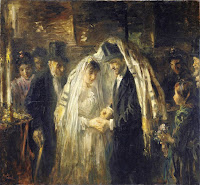 |
| A Jewish Wedding by Jozef Israëls (1903) |
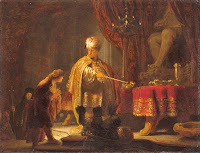 |
| Daniel and Cyrus Before the Idol Bel by Rembrandt van Rijn (1633) |
Orientalism of Jewish Wedding in Morocco Among Eugène Delacroix Artworks
 |
| The Wounded Cuirassier by Théodore Géricault (1814) |
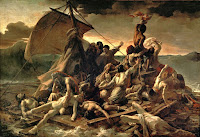 |
| The Raft of the Medusa by Théodore Géricault (1819) |
 |
| Self-Portrait by Jean-Auguste-Dominique Ingres (1859) |
Influence of Eugène Delacroix Paintings on Futuristic Art Movements
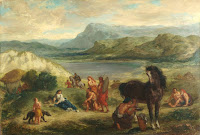 |
| Ovid Among the Scythians by Eugène Delacroix (1859) |
 |
| The Combat of the Giaour and Hassan by Eugène Delacroix (1826) |
 |
| Wanderer Above the Sea of Fog by Caspar David Friedrich (1818) |
Jewish Wedding in Morocco Painting Details, Violin, Saz and Tambourine
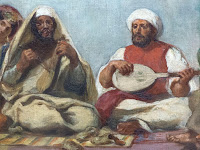 |
| Jewish Wedding in Morocco Details of Violinist and Guitarist |
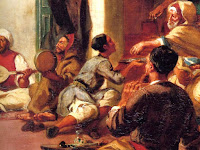 |
| Jewish Wedding in Morocco Details of Tambourine Player and Errand Boy |
 |
| Jewish Wedding in Morocco Detail of Moor on the Right |
 |
| Jewish Wedding in Morocco Details of Little Kid and His Parent |
Abraham Benchimol of Tangiers, as Jewish Guide to Delacroix
 |
| Jewish Wedding in Morocco Detail of Préciada |
 |
| Saada and Préciada by Eugène Delacroix (1832) |
 |
| The Birth of Venus by Alexandre Cabanel (1863) |
 |
| Venus and Mars by Sandro Botticelli (1485) |
Symbolism of Painting Figures and Objects in Jewish Wedding in Morocco
 |
| Jewish Wedding in Morocco Detail of Moor on the Left |
 |
| Study of Babouches by Eugène Delacroix (1823-1824) |
Pre Wedding Traditions of a Jewish Wedding in Morocco
 |
| Belshazzar’s Feast by John Martin (1820) |
 |
| Belshazzar’s Feast by Rembrandt van Rijn (1635-1638) |
 |
| Jewish Wedding in Morocco Details of Guest and Treats |
 |
| The Talmud Scholars by Carl Schleicher (1903) |
Jewish Wedding in Morocco Delacroix at the Met Museum Exhibition
 |
| The Battle of Nancy by Eugène Delacroix (1831) |
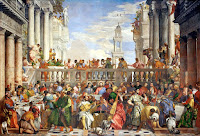 |
| The Wedding at Cana by Paolo Veronese (1563) |
 |
| Jewish Wedding in Morocco Detail of Guests on Top Floor |
 |
| A Basket of Fruit in a Flower Garden by Eugène Delacroix (1849) |
 |
| Lilacs by Paul Gauguin (1885) |
Pierre-Auguste Renoir The Jewish Wedding in Morocco after Delacroix
 |
| Jewish Wedding in Morocco by Pierre-Auguste Renoir (1875) |
 |
| Bal du Moulin de la Galette by Pierre-Auguste Renoir (1876) |
 |
| The Luncheon on the Grass by Claude Monet (1865-1866) |
Jewish Wedding in Morocco Romanticism, Legacy and Dimensions
Jewish Wedding in Morocco is one of the dramatic adjuvant
masterpieces to Delacroix’s Liberty Leading the People, among other most famous
paintings in the Louvre artworks, such as the priceless Mona Lisa by Leonardo
da Vinci, The Raft of the Medusa by Théodore Géricault, The Coronation of
Napoleon, The Intervention of the Sabine Women, and Oath of the Horatii by
Jacques-Louis David. But this genre painting varies from other Eugène Delacroix
works by representing a fairy tale alike evening entertainment of a Moroccan
Jewish family with their royal guests suited traditional Moroccan outfits. The
dimensions of this Eugène Delacroix tableau in the style of Orientalism and
Romanticism, is approximately 55,12 × 41,33 inches (105 × 140 centimeters).
 |
| Greece on the Ruins of Missolonghi by Eugène Delacroix (1826) |
Jewish Wedding in Morocco by Eugène Delacroix
 Reviewed by Articonog
on
January 26, 2023
Rating:
Reviewed by Articonog
on
January 26, 2023
Rating:
 Reviewed by Articonog
on
January 26, 2023
Rating:
Reviewed by Articonog
on
January 26, 2023
Rating:





No comments: